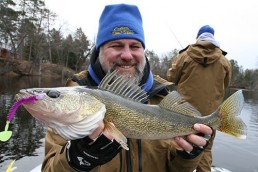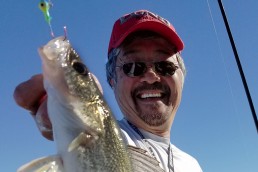Walleyes Love Plastics in Spring
SHARE THIS POST
The shore of the river looked muddy and extra slippery, but I was determined to head to the hot spot, which had always provided good action after a hard rain. And besides, what’s the worst that could happen? I found out a few seconds later as I was sliding down the bank heading toward the water. All I could think of was that I hoped nobody I knew was down here fishing. I also made a mental note that waders act like a wearable slip-n-slide. The feet-first entry into this river made for an abrupt stop, and I stood up like I had planned it all along—time to catch walleyes.
Once I was back up again, on the second cast, I tagged into a nice fish. They always fight harder in the cold, moving current, but this one fought extra hard. I thought it might be a trophy. It swam past me and headed downstream—obviously, this was no walleye. Since I couldn’t pull it upstream, I had to hike back downriver to gain line. Finally, after an exhausting battle between man and fish, man had won and the murky water revealed my trophy, a 20-pound carp. A true bonus fish, but I was after walleyes, so back upriver I went and I changed the color of my Ringworm.
Spring walleyes like moving water; the action really heats up below dams. But creek mouths, pools below riffle areas and even culvert ditches, will all hold fish. I’ve whomped on some big fat sows in front of culverts in channels connecting lakes after a hard spring rain.
As these walleyes make their migration to spawn, the smaller males arrive first and push all the way up the dams or to the swiftest current on a river. In lakes, they head to gravel shorelines. The females show up after, but will stage up deeper until the temperature is right. Usually, after the spawn, they’ll rest up in the flats. You just need to move about and try various areas to determine where the hot bite is. Also, you can catch pre-spawn, spawn, and post-spawn fish all from the same river or lake, depending on your location.
Hot tactics for these walleyes are jigging minnows, ripping blade baits, casting crankbaits and pitching a jig-n-plastic. Unless there is a bait shop on the way, I don’t worry about minnows. I catch more on plastics anyway.
The best action occurs at night, but you have to be careful whether you are fishing on shore, wading or searching by boat. Keep gear minimal, and don’t leave hooks and lures lying around. Also, have a good headlight with a backup and keep pliers handy for hook removal.
Whether you fish day or night, color plays an important factor. You can make repeated casts to walleyes up to a dam with a white jig-n-plastic where you know the walleyes are because you’ll see the swirls, fins and splashes. But if they don’t want white and you keep fishing a white jig-n-plastic, you won’t catch anything.
Are you enjoying this post?
You can be among the first to get the latest info on where to go, what to use and how to use it!
River action has already started this March, and will last until May or until the season closes in some states. The top rivers are the Rainy River on the Minnesota/Ontario border, the Fox River at De Pere and various dams in Wisconsin and Illinois, the Oconto, Peshtigo and Menominee all north of Green Bay in Wisconsin, the St. Croix in Minnesota, the Mississippi in Minnesota, Iowa, Wisconsin and Illinois and the Maumee in Ohio.
My favorite spring lure is a Ringworm. It’s a staple in every river rat’s tackle box. B-Fish-N Tackle revived the Ringworm revolution 10 years ago with 36 color combinations of their standard 4-incher. The key to the appeal, beside the color, are the rings, which make a bubbling sound when in motion and the large twister tail, which attracts fish through its noise too.
The key to a proper presentation starts with the weight of a jig. On some days, walleyes are tight to the bottom and a heavy jig is needed to keep in constant contact with the floor. However, a lighter jig allows the plastic bait to tic the bottom every so often, which is usually preferred by most fish, plus the lighter jig will not snag as much. I like to cast off to the side, slightly up- current and allow the bait to float and bounce downstream. I’ll then drag it back for another cast. When you get the hang of it, you’re almost steering it into the strike zone, and when the action gets hot, you just feel like you’ll catch a fish on the next cast.
The Moxi and Pulse-R are effective too. The Moxi is basically an oversized Ringworm with a larger, beefier belly and a longer twister tail. It emits a lot of vibration under the surface. The Pulse-R has that same beefy belly, but has a large thumper paddle tail instead of a twister. Purple with white tails are good, blues and a white tail or black with a white tail working in most rivers.
When choosing a jig head, you want one that holds a worm tight to the head and doesn’t hang up in the rocks and junk on the bottom. B-Fish-N H20 jigs fit the bill and their wire “keeper” is molded into the jig head to hold the plastic fast to the head. Jig weight makes all the difference in the action too. Just enough is all you need. The H20 jigs come in nine different weight sizes between 1/16 and 5/8 ounce.
There is no excuse to miss the walleye run this spring. All you need is a bag of plastic, a few jigs, a river and time. If you don’t have any of that, head to a tackle shop and call in sick from work and tell them you have “walleye fever.”
MWO
SHARE THIS POST
Did you enjoy this post?
You can be among the first to get the latest info on where to go, what to use and how to use it!
Walt Matan
Walt Matan has been a writer and television host for MidWest Outdoors for 30 years. An avid ice and open-water fisherman, he currently lives in the Quad Cities on the shores of the Mississippi River. He is the product developer and brand manager for Custom Jigs & Spins, B-Fish-N Tackle, and Rippin Lips Catfish Tackle. For more information visit customjigs.com.



